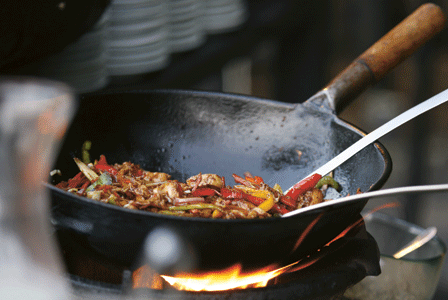
Stir-fries offer a colourful, creative way to prepare winter vegetables. Warm up with our healthy stir-fry recipes.
Nature knows what it’s doing. During cold weather, winter vegetables react to the cool climate by storing their powerful energy in their roots. Packed with immune-boosting compounds, vitamins, minerals, and fibre, these vegetables are the perfect food to help us stay healthy during cold and flu season.
After we arrive home tired at the end of the day, nothing could be easier to prepare and more nutritious than a dish of these seasonal champions. A stir-fry is a fast and delicious way to dish up veggies, taking little time to prepare and serve. Stir-fries offer great versatility and, best of all, easy kitchen cleanup. One of the simplest ways to prepare them is in a wok.
Here are three recipes combining winter vegetables with flavours and seasonings from some of the world’s tastiest cuisines.
Recipes
- Caribbean Jerk Stir-fry
- Tofu Stir-fry with Sriracha Chili Marinade
- Mouth-watering Mediterranean Stir-fry
How to stir-fry successfully
Stir-frying is a fast process, so it pays to be organized and have everything you need close at hand once you start cooking.
Stir-fry basics
Here are some general rules regarding stir-fry techniques. Simply follow these steps to make your own creations.
- Assemble and measure out all ingredients.
- Slice all vegetables the same size so they cook evenly, remembering that larger pieces take longer to become tender. Starchy root vegetables such as potatoes, parsnips, and sweet potatoes can be sliced thinly so they cook through more rapidly.
- If using meat or seafood, portion to required size, then keep refrigerated until ready to use.
- Clean and sanitize any surface that has been used to prepare raw seafood or meats.
- Organize prepped ingredients beside the cooking area.
- Warm wok or pan on medium-high heat, then add cooking oil of choice. Choose organic oils with a high smoke point such as peanut, coconut, or grapeseed oils.
- Swirl oil to coat wok.
- Cook meat or seafood first (if using), then set aside and keep warm.
- Wipe out the wok/pan with clean, absorbent cloth, add fresh oil, and reheat.
- Add aromatics such as garlic and cook 30 seconds to release their flavours.
- Add vegetables, stirring to coat with oil.
- Add a little water if veggies are sticking.
- When vegetables are almost done, add sauce ingredients.
- Stir to combine and bring liquid to a boil.
- Add cooked meat or seafood if using, stir to combine. Reheat and serve.
Choosing and using a wok
Choose a good-quality steel wok; avoid woks with nonstick surfaces as the nonstick coating will degrade over time. Most woks require seasoning before initial use, so follow the manufacturer’s instructions for this.
To clean after cooking, add water to the heated wok and bring to a boil, then dump out and wipe the surface. Do not use abrasive scrubbers or soap as the seasoned surface will deteriorate. In classic Asian cooking, woks are round-bottomed and heated over flame to 500 F (260 C) or higher. Modern home stovetops cannot deliver this kind of heat, so choose a flat-bottomed wok that sits directly on the burner for best results. Select one with a long, sturdy wooden handle to make handling easier during cooking.
Health benefits of winter veggies
Cruciferous family (broccoli, cauliflower, Brussels sprouts, cabbage)
- Contain anticancer properties, anti-inflammatory compounds, and intestinal health-boosting fibre
- Dense in nutrients; for example, broccoli is high in vitamins A, C, and K and is also a good source of calcium, magnesium, and manganese
Orange veggies (sweet potato, winter squash, carrots)
- High in antioxidant beta carotene and vitamin C
Alliums (onions, leeks, garlic)
- Rich in potent antioxidant sulphur and antibacterial compounds
Hardy greens (kale, Swiss chard, collards, mustard greens)
- High in vitamins A, C, and K as well as manganese, calcium, and fibre

